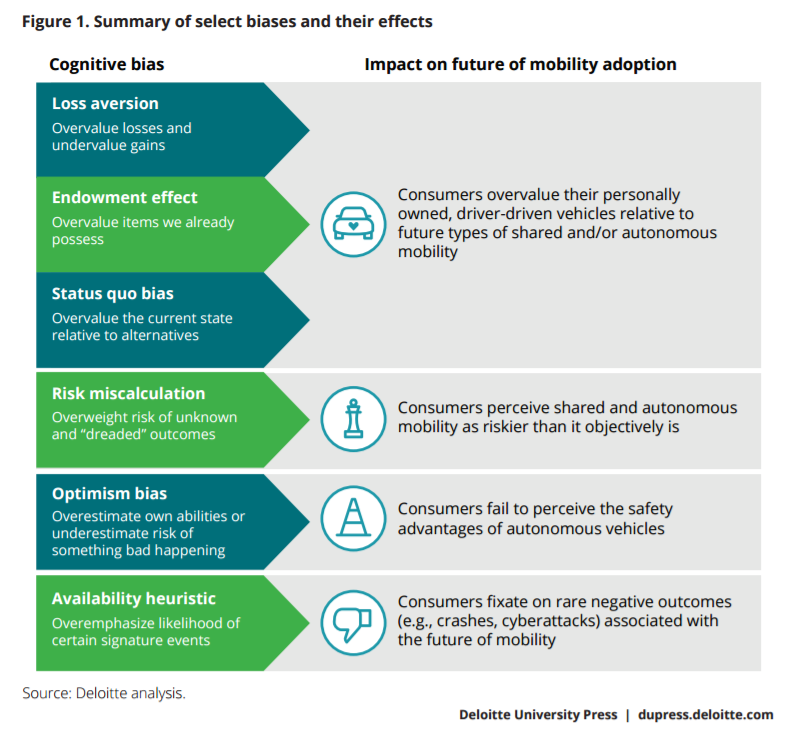The automotive industry is in the early stages of a potentially transformative evolution where today’s personally owned, driver-driven vehicles likely will travel alongside shared and self-driving cars.
The speed with which this future vision arrives hinges on both technological and regulatory advances and on how quickly consumer expectations and behavior shift. Because even if the benefits of a world of shared self-driving cars seem self-evident, companies should not assume consumers will reach a similar conclusion.
In fact, peoples’ cognitive biases suggest many individuals may be reluctant to relinquish their personally owned and driver-driven vehicles.
Human behavior often can lead us to delay or forgo adopting new technology (in this case, shared and autonomous vehicles), even if that technology provides demonstrable benefits. While research in behavioral economics and social psychology has revealed deep and consistent biases that can lead to suboptimal choices, it also has uncovered potential ways to overcome these mental limitations.
By constructing choices and framing new mobility options in ways that encourage adoption, companies, governments, nonprofits and others can help ensure the future of mobility arrives sooner rather than later.
For decades, researchers have documented the ways in which human decision-making departs from classic assumptions of rational, cost-benefit calculation. Some salient biases that could lead customers to balk at adopting such technological and service innovations are shown below.

The significant investments being made in the future of mobility could be undermined without a careful and thorough consideration of how consumers might perceive and adopt these new technologies and services. Here are a handful of lessons from behavioral economics that can be used to “nudge” consumers and help overcome cognitive barriers to adoption:
- Recast losses as forgone gains and gains as forgone losses. Because losses typically are overvalued relative to gains, advocates might stress what a consumer would miss by not choosing an autonomous vehicle. Similarly, negative framing also can be effective. So instead of promoting the idea that “Buying a driverless car saves lives,” advocates might consider a variation of “Not buying a driverless car costs lives.”
- Aggregate the costs and risks. To overcome potentially skewed perceptions of loss and risk, consider expanding the relevant timeframe or pooling the costs. Proponents of shared and autonomous mobility could emphasize the average time lost in an entire year to commuting (31 days for so-called “mega commuters”), rather than the few minutes that accrue every day.
- Create social proofs. We often look to the behavior of others for clues as to the correct course of action. Such “social proofs” can serve as powerful motivators, and messaging that invokes peers is often effective in changing behavior.
- Set default options. Creating pre-selected options can have a powerful effect on what we ultimately choose. To encourage uptake, service providers can make shared or autonomous mobility the default option.
- Make autonomy a peripheral, rather than a core, feature. In a study of car “autopilot” technology, survey respondents were presented with one of three scenarios: an integrated self-driving system that is the only way to control the vehicle; an integrated system that also had the option of human control; and a vehicle with a plug-in accessory that offered self-driving capabilities. Those presented with the latter condition (add-on option) were two to three times more likely to sign up for a test drive.
Shared mobility and autonomous vehicles offer many potential benefits, and while important developments emerge nearly daily, the future of mobility still lies ahead of us. How quickly that future emerges is likely to depend not only on the merits of emerging technological solutions, but also on how well key players understand and address consumers’ cognitive biases.
Derek Pankratz is a research manager with the Center for Integrated Research in Deloitte Services. His research focuses on the confluence of emerging technological and social trends across industries.





